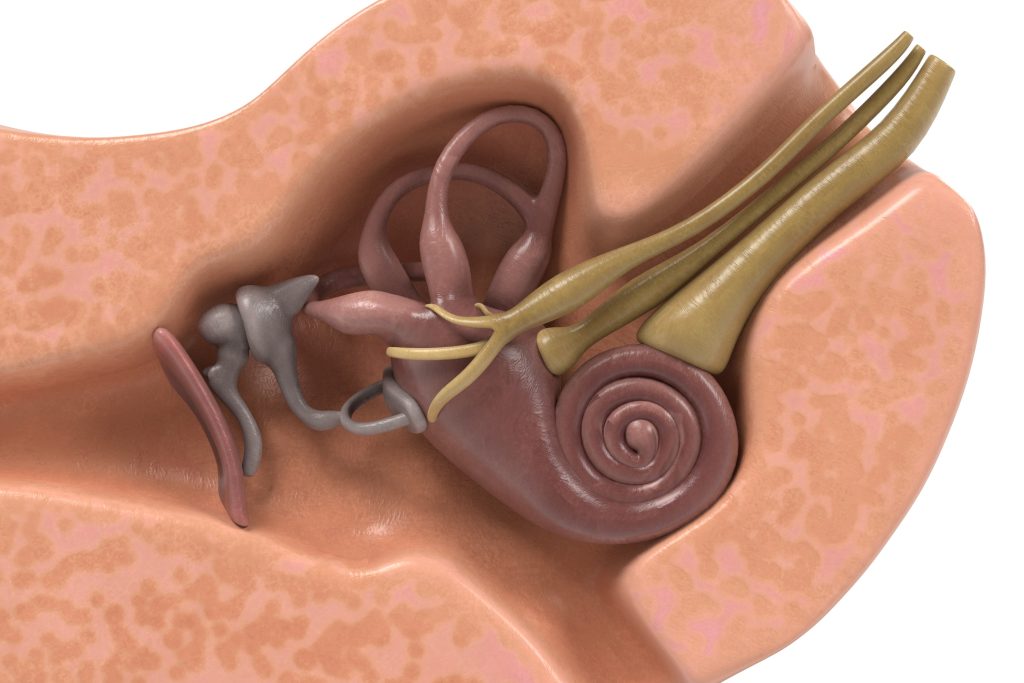Dr Millie Nakatsuka | Decoding Dizziness in the Emergency Room
Acute vestibular syndrome is one of the most common reasons people present at hospital with dizziness. The symptoms can arise from damage within the brain or the ear, and specialist medical knowledge or equipment is typically needed to determine the specific cause. Dr Nakatsuka from the University of Sydney in Australia has conducted a large-scale analysis and review of the published literature to determine if well-trained emergency physicians can differentiate between the two causes using a quick bedside physical examination without expensive special equipment.
Acute Vestibular Syndrome
Acute vestibular syndrome (AVS for short) is the onset of sudden and intense feelings of spinning or dizziness, often accompanied by nausea, balance problems, and involuntary eye movements known as nystagmus. These symptoms can all be caused by damage or disease in the vestibular system – the network responsible for maintaining our sense of balance and spatial awareness. AVS can either be central (i.e., related to the brain) or peripheral (i.e., related to the inner ear). Knowing the location of the damage helps doctors identify which patients may be suffering from a potentially life or brain-threatening medical condition. This is because central AVS is associated with severe morbidity. In contrast, peripheral AVS is a common condition of the inner ear or 8th cranial nerve, which is not lethal (e.g., mild viral infection).
Central and Peripheral Causes
Diagnosing AVS and categorising the cause as either central or peripheral can be achieved by gathering a medical history, conducting physical and neurological examinations, and using complex diagnostic technology such as video-oculography (VOG).
Doctors and healthcare workers can perform a HINTS examination to differentiate between central and peripheral AVS. The HINTS examination consists of three components: Head Impulse, Nystagmus, and Test of Skew. The head impulse test involves rapid horizontal movements of the patient’s head while the patient focuses on a fixed point. Nystagmus are involuntary eye movements. Factors such as the presence or absence and direction of these movements can indicate if AVS is central or peripheral. The test of skew analyses the alignment of the eyes; in central AVS, imbalances in the eye muscles can lead to one eye appearing higher than the other. The original HINTS examination was established in 2009. Since then, variations have been released, including the HINTS-PLUS, which includes a hearing test, and the STANDING algorithm (SponTAnous or positional, Nystagus Direction, Head Impulse test, StaNdinG).
VOG uses video goggles or a specialised camera to track a patient’s eye movements. It is highly accurate and may capture subtle abnormalities that would be missed by a physical examination. It is also a highly specialised piece of equipment requiring trained healthcare staff to perform the tests and interpret the results.

Problems with Differentiation
A recent review paper found that less than 20% of patients who came to hospital with severe dizziness underwent a HINTS examination. Several studies have suggested that only specialised doctors such as neuro-ophthalmologists or neuro-otologists (specialists in eye or ear problems relating to the nervous system) are able to correctly conduct and interpret physical and neurological examinations such as the HINTS examination (which is better than an early MRI in identifying stroke). The findings of these studies are particularly concerning when we think about the care of patients attending rural or remote hospitals that may not have access to doctors in every speciality or VOG technology.
Dr Millie Nakatsuka of the University of Sydney in Australia has a special interest in neuro-ophthalmology and a particular interest in health inequality in regional and rural hospitals. Working with a multidisciplinary team, Dr Nakatsuka conducted a large-scale review of published studies to evaluate whether appropriate training and education can allow emergency doctors to use the HINTS examination (or the latter variant) and, thus, effectively distinguish between central and peripheral AVS.
The team began by looking at 1,757 results from all the major clinical journals and clinical trial records. Of these, 27 were deemed appropriate for further consideration. Articles were screened against multiple factors to ensure they met the stated criteria for clinician education and did not contain significant bias. After being screened, five studies were available for qualitative (descriptive and interpretative) analysis and two for quantitative (numerical) analysis.
More information was available on the STANDING algorithm than the traditional HINTS examination and its variations. Data supported the proposal that emergency doctors who are well-trained and educated can use the STANDING algorithm to identify central AVS in comparison to AVS with a peripheral cause. The STANDING algorithm offers high levels of sensitivity – meaning that 96% of cases of central AVS were accurately detected, and also high levels of specificity – meaning that 88% of non-central AVS cases were ruled out, when administered by trained emergency doctors.
The researchers did not find enough evidence to fully support emergency doctors’ use of the original HINTS examination. However, they did report that two separate research studies are currently being conducted to assess the reliability of HINTS when performed by trained emergency doctors.
Implications for Diagnosis in Resource-limited Settings
Dr Nakatsuka’s study is the first provision of high-quality evidence supporting the diagnostic accuracy of the STANDING algorithm when conducted by trained point-of-care emergency doctors. As such, the team’s findings contradict previous reports concluding that bedside physical examinations for AVS should only be conducted by specialist doctors.
In Australia, only 25% of public hospitals are in major cities, with rural and regional hospitals facing large disparities in access to medical specialities and diagnostic technology such as VOG. The results of Dr Nakatsuka’s work are particularly important for less well-equipped hospitals as they highlight that if staff are given adequate education and training, patients will be able to be rapidly and accurately classified as having central or peripheral AVS without having to travel to a large well-resourced city hospital (which is not practical or feasible).
Increasing interest in using smartphones to record eye movements to aid AVS diagnosis also emerged in Dr Nakatsuka’s work, illustrating the useful application of technology and clinical skills. She hopes to build upon this current work by conducting further research on the education and training needed by point-of-care healthcare professionals to provide robust AVS differential diagnoses.
SHARE
DOWNLOAD E-BOOK
REFERENCE
https://doi.org/10.33548/SCIENTIA919
MEET THE RESEARCHER

Dr Millie Nakatsuka
Discipline of Clinical Ophthalmology and Eye Health
University of Sydney
Sydney
Australia
Dr Millie Nakatsuka gained her medical degree from Bond University in 2013 and has since specialised by obtaining a Master of Medicine (Ophthalmic Science) from the University of Sydney. Over her career to date, Dr Nakatsuka has gained valuable experience in various health services across Australia, working in emergency medicine, general medicine, ophthalmology, and psychiatry. She is particularly interested in neuro-ophthalmic emergencies, eye movement and cognitive function abnormalities in schizophrenia, and the potential ocular complications of medications. Dr Nakatsuka is currently studying towards a Master of Public Health with a focus on evidence-based and cost-effective clinical practice. Her overarching aim is to address health inequality in regional and rural hospitals in Australia.
CONTACT
E: Millie.Nakatsuka@health.qld.gov.au
KEY COLLABORATORS
Emma E. Molloy, West Moreton Health Service, Queensland, Australia
FURTHER READING
M Nakatsuka, EE Molloy, The HINTS examination and STANDING algorithm in acute vestibular syndrome: A systematic review and meta-analysis involving frontline point-of-care emergency physicians, PLoS ONE, 2022, 17(5), e0266252. DOI: https://doi.org/10.1371/journal.pone.0266252

REPUBLISH OUR ARTICLES
We encourage all formats of sharing and republishing of our articles. Whether you want to host on your website, publication or blog, we welcome this. Find out more
Creative Commons Licence (CC BY 4.0)
This work is licensed under a Creative Commons Attribution 4.0 International License. 
What does this mean?
Share: You can copy and redistribute the material in any medium or format
Adapt: You can change, and build upon the material for any purpose, even commercially.
Credit: You must give appropriate credit, provide a link to the license, and indicate if changes were made.
SUBSCRIBE NOW
Follow Us
MORE ARTICLES YOU MAY LIKE
Dr Ralf Adam | New Technologies Shaping the Future of Oral Hygiene
Understanding the efficiency of various toothbrush technologies is essential for achieving optimal oral health. Dr Ralf Adam, who leads a dedicated team at Procter & Gamble in Germany, is keen to investigate the complexities of these technologies. His team have provided new insights into the best toothbrush types for plaque removal and the maintenance of gum health. By highlighting the importance of informed oral care decisions and ongoing investigations, this vital research works towards ensuring everyone can achieve a brighter, healthier smile.
Dr Toby Phesse | Revealing the Mysteries of Wnt Signalling: Novel Approaches to Beating Cancer
Cancer remains a leading cause of mortality worldwide, and the need for new, more effective treatments remains an urgent challenge. Dr Toby Phesse from Cardiff University in the UK focuses on the role of the Wnt receptor found on the surface of cells and its involvement with cell communication and cancer growth, bringing fresh hopes for new therapeutic options.
Dr Vijay Reddy | The Virus World Database: An Invaluable Resource for Public Health and Healthcare
Severe viral disease presents an ongoing challenge to the health of humankind. While unparalleled developments in science and technology are improving our understanding of such viruses, this information needs to be readily accessible to researchers to ensure continued progress in public health and healthcare. Dr Vijay Reddy and his colleagues at the Hormel Institute (University of Minnesota) developed the Virus World database, an invaluable resource that details the genome, structure, and host of practically every discovered virus to date.
Professor Ralf Herwig | Deciphering the Enigma of Vitamin D and the Immune System
Vitamin D has been studied as a treatment for a large number of diseases and conditions, from cancer to autism to COVID-19. However, its mode of action is not completely understood. Professor Ralf Herwig carries out his research at HG Pharma GmbH (Austria) and Ulster University (UK). His vital work explores the role of vitamin D in the body with a view to unlocking its potential as a treatment for a variety of health conditions involving the immune system.





